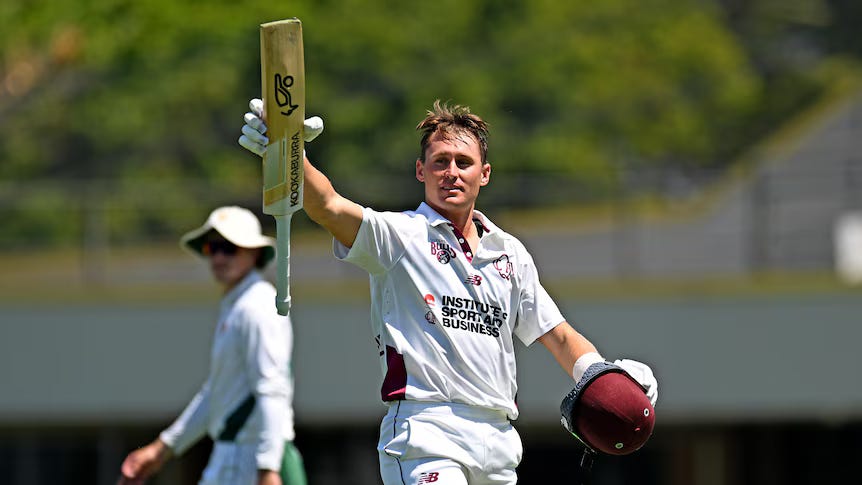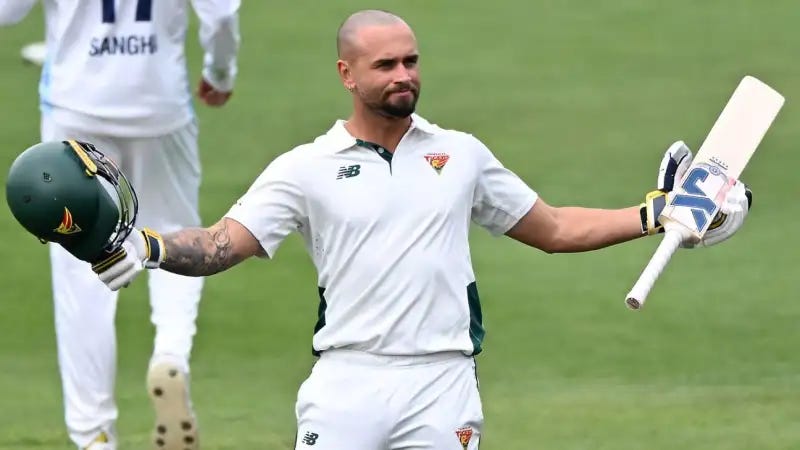'Tis that time of the year. Who will they play? Who would I select?
And, Marnus Labuschagne makes a case for reestablishment in the best possible way.
With three premier rounds completed, that’s in Melbourne, and more in other cities. Bilateral ODIs in the bank and theT20s underway, three rounds of Shield cricket settled, Pat Cummins injury concerns clouding the horizon, and an Ashes selection debate continuing to dominate the domestic discussion: cricket in the Southern hemisphere is well and truly back, because ‘tis that time of the year.
The premier stuff matters little in the bigger picture, although it is worth noting that Harjas Singh (Western Suburbs) recorded a triple century in a first-grade one-day Sydney premier game. Yes, he made 314 from 141 balls. Singh hit a total of 35 sixes. His extraordinary innings placed him third on the all-time list in New South Wales Premier first grade history, behind Victor Trumper’s 335 in 1903 and Phil Jaques’ 321 in 2007. Harjas was suitably modest when questioned later, “Definitely that’s the cleanest ball-striking I’ve ever witnessed from myself, for sure.”
And one further note on Premier cricket. Victoria switched from the Kookaburra Regulation ball to the Turf ball. Centuries have duly followed with a line of disgruntled medium-pacers ready to argue the change. Of the batters, Farzan Chowna (Melbourne) is the leading beneficiary with consecutive hundreds; however, Chowna might have to wait a while longer for his crack at the big-time—although McDonald and co are apparently looking for an opener!
The ODIs with India carried not much more significance than Premier cricket. However, the second game in Adelaide proved to be a watershed moment in the cottage industry of cricket broadcasting. In a similar fashion to ChatGPT’s release (November 2022), Fox cricket’s commentary team were presented with a new toy, and how they flogged it—as a coach and previously a player, the virtues of weight transfer, when batting, were, as a player, fanciful, and then as a coach, a virtue. Getting ‘back into’ when driving the quicks is all well and good for a select few; for mortals, it’s just one of those things you wish you could do.
“I present the new graphic that illustrates, from side-on, a batter’s progression of weight transfer from ball release, to contact, and beyond.” The first shot was a Shubman Gill signature cover-drive that split the offside field. We saw his trigger, stop, tracking, then his movement into the drive, contact, and follow-through. Ravi Shastri was on the mic and demonstrated his unerring capacity to ‘state the obvious’—on replay, he read the percentage change perfectly, halting his analysis on ball-contact, so stating what we all saw that the ideal percentage is mid-seventies on the front foot, which then moves to 90% at the end of the shot. Soon after, there was a commentary change, which saw Mark Howard, Mike Hussey, and the opinionated Brad Haddin assume the weight transfer analysis. Haddin moved the contact mark back to a 60/40% front-foot position; Hussey astutely observed that there is no hard and fast rule, as it will change for different bowlers (I would have been in the front-foot minuses against Allan Donald). And Mark Howard, as he always does, tried to plead ignorance but gave his opinion anyway. And then, before you had time to take a position, the debate was over, and the team moved on to a new toy.
SpeakingCricket is made possible by your subscriptions. If you’re still a free subscriber, please consider upgrading to a paid subscription. Your support truly makes a difference.
And to the Ashes, and who will play. As an observer and writer (commentator), surely the question should be: “Who do you think should play?” Not, “who do you think they will pick?” The moment is for you to present your opinion and argument, not report on who they (the selectors) will pick—I will concede there is a difference between reporting and opinion.
I have Marnus in—he has thankfully, and finally, returned to a runs-first approach, so ditching his need to look the goods at the expense of run-making— the currency of batsmanship (how else can you say it!). His method looks instinctive again, the head position is neutral, his footwork assertive, and his alignment in address and in-shot is clean and repeatable—I hope he makes some in Perth! So, for me, he bats three, and has the opportunity to outscore his opposite number—one of England’s soft spots.
Beau Webster is an interesting cricketer, perhaps below par in both disciplines, but combined, and as a stopgap, he hasn’t let anybody down. His delayed return to Shield cricket and a quiet game (on a difficult pitch) in Melbourne will make it hard for the selectors to pick both him and Cameron Green—assuming Green’s bowling loads are managed and he is fit to play an active bowling role in Perth.
With this said, and Green moving back to six, Bailey and co need to fill one more gap—for now! If I had to hand the teamsheet in right now, it would be:
Usman Khawaja, Farzan Chowna, Marnus Labuschagne, Steve Smith, Travis Head, Cameron Green, Alex Carey, Mitchell Starc, Nathan Lyon, Scott Boland, Josh Hazlewood.
No, please, come on, be serious! But seriously, it feels like there is no one jumping off the page, or it’s just too obvious for me to see, and Jake Weatherald should play. Or is it Matt Renshaw?
Renshaw has some history, and most of it is negative. The positive is 14 Tests in the bank, including a century. To counter that in the 2024/25 Sheffield Shield season, Renshaw scored 496 runs from 10 matches, averaging 29.17. Compare that to Weatherald, who scored 906 runs at 50.33. The one stat that stands out in his first-class record is his 50 to 100 conversion rate: 23 fifties and 24 hundreds—I’m not able to think of anyone who has more hundreds than fifties from the games he’s played (128).
Weatherald was another victim of the challenging Junction Oval this week. His two outs were to excellent deliveries, and, as is the life of an opener, both dismissals were just before the close of play—the dreaded ‘red-time’.
Still, I have Weatherald in my starting XI.
Usman Khawaja’s run is coming to an end, and Weatherald looks a likely medium to long-term alternative, with the other opening spot on ice for a younger player—Sam Konstas, Campbell Kellaway, or the like.
So if asked to name a 14-man squad, this would be it—not who I think they will pick—just my selections:
Usman Khawaja, Jake Weatherald, Marnus Labuschagne, Steve Smith (c), Travis Head, Cameron Green, Alex Carey, Mitchell Starc, Nathan Lyon, Scott Boland, Josh Hazlewood, Brendan Doggett, Josh Inglis, Sean Abbott.
Disclaimer: I did speak at a dinner with Tony Dodemaide last month (Koringal Golf Club). But those at the dinner will attest to Tony’s inability to spill any Ashes selection beans, this despite my insistent hounding; he played a straighter bat than Boycott.






You left out the Mitch Marsh “Smash em early” strategic plan Nick.